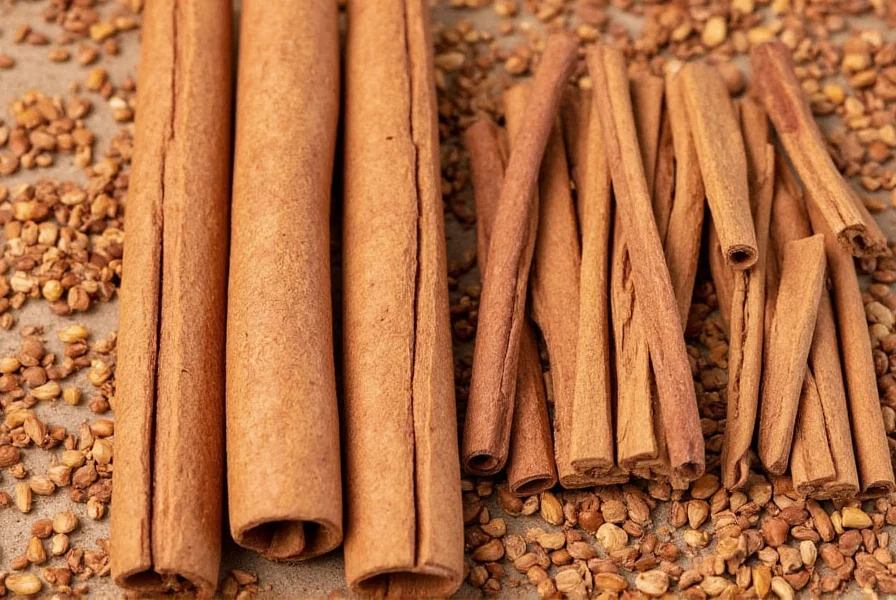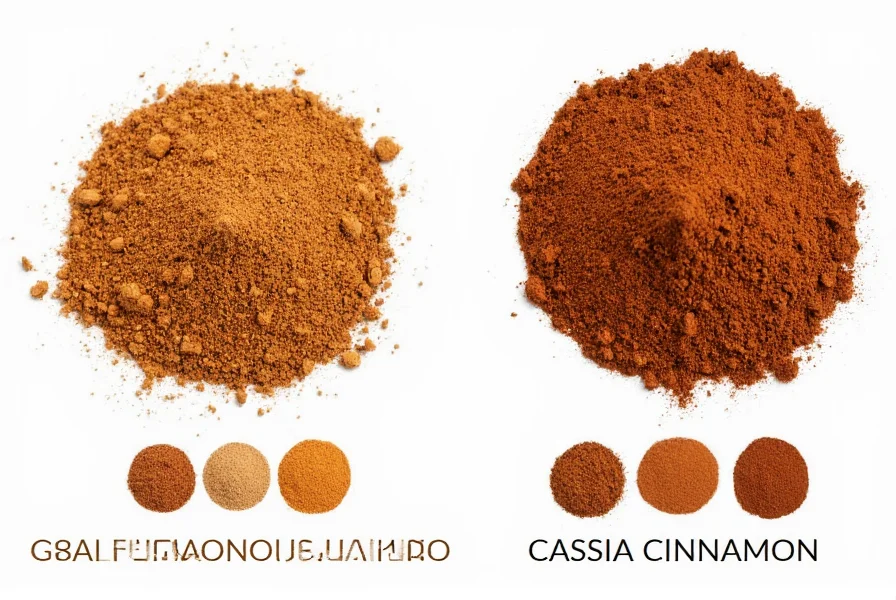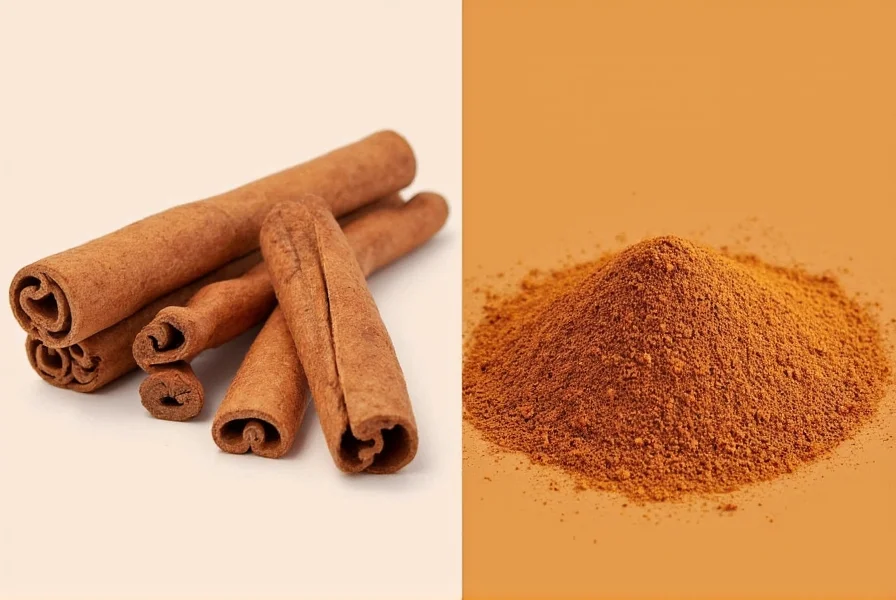True cinnamon (Ceylon cinnamon) and cassia cinnamon come from different tree species. Ceylon (Cinnamomum verum) has a delicate flavor, lighter color, and contains significantly less coumarin than cassia (Cinnamomum cassia), which is stronger, darker, and more commonly sold as “cinnamon” in supermarkets. The coumarin content in cassia can pose health risks with regular high consumption.
Many consumers don't realize they're probably using cassia cinnamon rather than true cinnamon. This confusion matters because these two spices, while similar in appearance and often labeled interchangeably, have important differences in composition, flavor, and health implications. Understanding the distinction between Ceylon and cassia cinnamon helps you make informed choices for both culinary and health purposes.
What Exactly Is True Cinnamon?
True cinnamon, scientifically known as Cinnamomum verum (formerly Cinnamomum zeylanicum), originates from Sri Lanka and southern India. Often called Ceylon cinnamon ("Ceylon" being the former name of Sri Lanka), this variety represents only about 10-15% of the global cinnamon market.
Ceylon cinnamon features multiple thin, brittle layers that form a delicate, hollow tube. Its color ranges from light tan to light brown, and it has a subtle, sweet flavor with citrusy notes. Because of its more complex harvesting process and limited production, true cinnamon typically costs two to three times more than cassia.

Understanding Cassia Cinnamon
Cassia cinnamon (Cinnamomum cassia), sometimes labeled as Chinese cinnamon, constitutes approximately 85-90% of cinnamon sold in the United States and Europe. Despite being less expensive and more widely available, cassia isn't technically “true” cinnamon from a botanical perspective.
Cassia cinnamon comes primarily from China, Indonesia, and Vietnam. Its sticks consist of a single, thick, hard layer that doesn't form a complete tube. Cassia has a darker reddish-brown color and a stronger, more pungent flavor profile with less sweetness than Ceylon. The robust flavor makes it popular in baking and commercial food production where a pronounced cinnamon taste is desired.
Key Differences Between Ceylon and Cassia Cinnamon
Understanding the practical differences between these two varieties helps consumers make appropriate choices based on their needs. The following comparison highlights the most significant distinctions:
| Characteristic | True Cinnamon (Ceylon) | Cassia Cinnamon |
|---|---|---|
| Scientific Name | Cinnamomum verum | Cinnamomum cassia |
| Origin | Sri Lanka, India | China, Indonesia, Vietnam |
| Appearance | Multiple thin layers, light tan, soft texture | Single thick layer, dark reddish-brown, hard texture |
| Flavor Profile | Mild, sweet, citrus notes | Strong, spicy, less sweet |
| Coumarin Content | Approximately 0.017 mg/g | Approximately 3.36-10.9 mg/g |
| Price | Higher (2-3x cassia) | Lower |
| Market Share | 10-15% | 85-90% |
The Critical Coumarin Difference
The most significant health-related difference between these cinnamon varieties involves coumarin content. Coumarin is a naturally occurring compound that gives cinnamon its distinctive aroma but can cause liver damage in sensitive individuals when consumed in large amounts over time.
Cassia cinnamon contains substantially higher levels of coumarin—up to 1,000 times more than Ceylon cinnamon according to some analyses. The European Food Safety Authority has established a tolerable daily intake of 0.1 mg of coumarin per kilogram of body weight. For a 150-pound adult, this translates to approximately 6.8 mg of coumarin daily.
A single teaspoon of cassia cinnamon may contain 5-12 mg of coumarin, potentially exceeding the recommended daily limit. In contrast, you would need to consume over 30 teaspoons of Ceylon cinnamon to reach the same coumarin level. This difference makes Ceylon the safer choice for regular consumption, particularly for children, pregnant women, and individuals with liver conditions.
How to Identify True Cinnamon vs Cassia
Most grocery stores sell cassia but label it simply as “cinnamon.” To identify which type you're purchasing:
- Check the label: Look for “Ceylon cinnamon,” “Cinnamomum verum,” or “True cinnamon”
- Examine the sticks: Ceylon forms multiple thin layers like a cigar; cassia is a single thick, hard layer
- Consider the price: If it's very inexpensive, it's likely cassia
- Taste test: Ceylon has a more delicate, sweeter flavor
Specialty spice shops, health food stores, and online retailers specializing in authentic spices are more likely to carry genuine Ceylon cinnamon. When purchasing ground cinnamon, identification becomes more challenging, as the two varieties look nearly identical once powdered.

Which Type Should You Choose?
The best cinnamon variety depends on your specific needs and usage patterns:
Choose Ceylon cinnamon when:
- You consume cinnamon regularly (daily or multiple times weekly)
- You're using it for health purposes or supplementation
- You're preparing dishes for children or individuals with liver conditions
- You prefer a more delicate, complex flavor profile
Choose cassia cinnamon when:
- You're using it occasionally in recipes that benefit from its stronger flavor
- You're making baked goods where the robust flavor is desirable
- Budget constraints make the higher price of Ceylon prohibitive
- You're using small amounts infrequently (less than 1 teaspoon occasionally)
Addressing Common Misconceptions
Several myths persist about these cinnamon varieties that deserve clarification:
Myth: Cassia cinnamon is “fake” cinnamon
Reality: Cassia is a legitimate spice with its own culinary value—it's just not botanically classified as “true” cinnamon.
Myth: All cinnamon has dangerous levels of coumarin
Reality: Only cassia contains concerning levels; Ceylon cinnamon has minimal coumarin.
Myth: The coumarin in cassia makes it unsafe for anyone to consume
Reality: Occasional use in normal culinary amounts poses minimal risk for most healthy adults.
Practical Usage Guidelines
To enjoy cinnamon safely while maximizing flavor benefits:
- For daily consumption (such as in morning coffee or smoothies), choose Ceylon cinnamon
- When using cassia, limit intake to no more than 1 teaspoon per day for adults
- Children should consume even smaller amounts—consult a healthcare provider for specific recommendations
- Rotate between cinnamon varieties to minimize potential risks while enjoying different flavor profiles
- Store both types in airtight containers away from light to preserve freshness and potency











 浙公网安备
33010002000092号
浙公网安备
33010002000092号 浙B2-20120091-4
浙B2-20120091-4